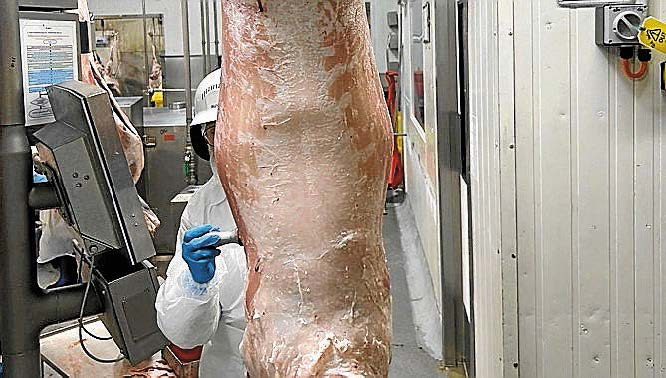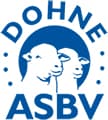Move to Dohne pays off
Quality carcase traits lift returns
Article courtesy of ACM (Kylie Nicholls) The Land, Stock & Land, Stock Journal
Copy of publication – click here
The dual-purpose traits of the Dohne breed have significantly boosted the productivity of the Argent-Smith family’s sheep flock in New South Wales, improving fertility as well as the early growth and carcase quality of their lambs.
Based at Rankin Springs in the state’s northern Riverina, Richard and Sally Argent-Smith and their family, along with Sally’s parents Bruce and Penny Black, currently run 1800 pure Dohne ewes in the mixed farming operation, Yaccabri Pastoral Company, alongside a 2500-hectare cropping program, comprising wheat, barley, canola, vetch and lupins.
Traditional Merino breeders, the family experimented with a Dohne/Merino-cross before making the decision to transition to a pure Dohne flock about five years ago.
“Although we were getting about $10 less for the Dohne wool compared with Merino wool at that time, we were receiving at least $50 more for the lambs and I based my decision on those returns,” Mr Argent-Smith said.
“The Dohne is the perfect dual-purpose sheep, it’s an easy-care, robust breed that fits in well with our cropping operation, handles our harsh environment and the lambs do very well when finished on barley in a feedlot.”
With assistance from sheep classer Angus Munro, Mr Argent-Smith has been sourcing his rams from the Nadin family’s Macquarie Dohne stud, based at Ballimore, NSW.
Their mature Dohne ewes currently average 20-micron with a wool cut per head of between 6-7 kilograms.

Sally and Richard Argent-Smith, Yaccabri Pastoral Company, Rankin Springs, NSW, made the change to a pure Dohne flock about five years ago and continue to be pleased with their performance. Pictures supplied
CONSISTENT PERFORMERS
Value-adding to their sheep enterprise, Mr Argent-Smith has established an on-farm feedlot. The family joins their ewes in November to start lambing in April, with shearing at the end of July.
Lambs are weaned in early September, shorn post-harvest in early December, and then enter the feedlot from January onwards at around 45kg live weight.
They are fed a ration of barley and lupins, all sourced on-farm, with barley straw supplied for roughage.
“We are targeting a heavy export lamb averaging 28-32kg dressed weight,” Mr Argent-Smith said.
“The first draft of lambs is usually ready after five weeks, while the lighter lambs might stay in the feedlot for up to two months.
“We want to have the feedlot emptied by the end of March ahead of the cropping program.”
Mr Argent-Smith introduced eID tags with the 2024-drop lambs, allowing him to more closely monitor individual performance and track their weight gains through the feedlot.
“We are definitely achieving better weight gains with the Dohnes, averaging about 2.5kg of live weight gain per week,” he said.
“But the biggest thing we have noticed is the consistency of the lambs, we don’t have the tail that we used to get with the Merinos.”
CARCASE BONUS
Mr Argent-Smith has generally sold his lambs through the Griffith Livestock Marketing Centre, NSW, but this year he decided to trial sending a line direct to Gundagai Meat Processors, keen to receive detailed carcase feedback.
“We sent 214 of our second line of lambs to Gundagai in February 2025 and they averaged a dressed weight of 29.84kg and returned $243 per head.
“What we were very pleased with was that 71 per cent of the draft received the Gundagai Lamb Quality 5+ score bonus which is worth 80 cents/kg, equating to a price of $8.36c/kg.
“We also received $8.50/hd for the skins, bringing the total return to $251/hd.”
The Dohne lambs had also been shorn with the return from their wool averaging $25/hd.
“For us the results have confirmed that we’re producing the right type of Dohne lamb that fits the bill for the Gundagai Lamb brand.
“We’ll definitely try to send some more next year.”

The family sent a line of Dohne lambs to Gundagai Meat Processors, with 71 per cent achieving the GLQ5+ bonus.
HITTING THE SPECS
According to Gundagai Meat Processors supply chain manager Dr Michelle Henry, Dohne and Dohne-cross lambs have been performing well through the Gundagai Lamb grid.
“We process a reasonable number of Dohne and Dohne-cross lambs through the Gundagai Lamb brand each year,” Dr Henry said.
“They are good meat Merinos that have a cleaner body which is good for processing, and we enjoy seeing them come through the brand.”
Dr Henry said as with any breed, the company has seen both high-quality and lower-quality lambs processed, as producers and livestock agents continue to learn more about what is required to meet the Gundagai Lamb grid specifications.
“This does result in variability in the percentage that achieve the GLQ5+ score, which measures intramuscular fat and lean meat yield,” she said.
“Dohne lambs tend to hit the middle of the grid for lean meat yield percentage.
“The Dohne lambs that are performing well have higher average intramuscular fat that ensures they are receiving a higher GLQ score, combined with a lean meat yield that hits the middle of the grid.”
Dr Henry said the lambs achieving a higher GLQ5+ percentage also tend to have a higher average hot standard carcase weight, ranging between 26-28kg.
“This emphasises the importance of Dohne and Dohne-cross lambs coming to us well-finished with good levels of subcutaneous fat cover.”










 Facebook
Facebook YouTube
YouTube Instagram
Instagram